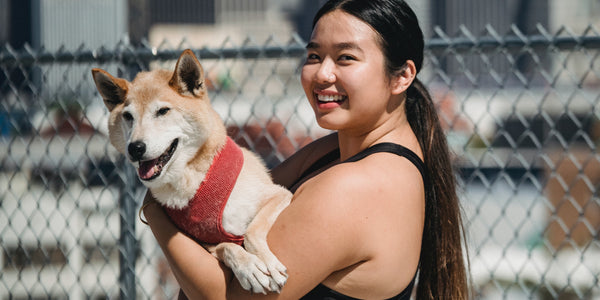Every pet owner at one time or another has wished that they could have a conversation with their dogs. As much as we “talk” to our dogs, we actually do not understand when they attempt to communicate back to us. Understanding your dog through their body language and being able to determine what they are trying to tell us will greatly help us get much closer to being able to communicate and understand our furkids.
Did you know that just because a dog is growling, it doesn’t necessarily always mean that he is angry or ready to attack? More often than not, dogs growl when they are afraid.
Some dogs may choose to whine or cry when they are apart from their owners, but this might also be an indicator that they are sick or in pain.
So how do we tell which is which? Kohepets is here to help you better understand your dog’s feelings through his/her body cues.
How to Read Your Dog’s Body LanguageEven if they cannot speak our language, dogs are actually very expressive. They are able to communicate a wide variety of emotions such as happiness, sorrow, fear and anger though their body language and facial expressions. However, one must be able to pick up on these non-verbal cues. Once you are able to identify these signals, you will find understanding your dog is much easier and figure out what your dog is trying to tell you.
Certain body cues can have several different meanings. For example if your dog is yawning, it could mean that he or she is tired or it might also mean that they sense some type of danger or immediate threat. Dogs use yawning as a method of deflecting threats and avoiding conflict with other nearby dogs. This is your dog’s way of saying he / she feels threatened or anxious, but is not going to attack.
Signs that Your Dog is Stressed Out, Uncomfortable or Nervous
The following signs may indicate that your dog is either nervous, anxious or experiencing some type of discomfort:
- Licking their lips constantly
- Remaining still in a tense posture (may stand perfectly still before reacting)
- Turns away head but keeps his eye on the object/subject in question
- Lowered tail
- Furrowed brow
- Shaking or shivering
- Tense or clenched jaw
- Sweaty Paws (Dogs do sweat on parts of their bodies not covered by fur)
- Inability to focus
- Clinging to owners
- Drooling
- Dry, raspy panting
- Twitching whiskers
- Hair on the back of the neck stands up (similar to goosebumps)
Signs of Deference or Appeasement
Deference is meant to avoid fights or injury or appease a perceived threat. This is normally shown by the dog exhibiting signs of submission such as lowering its body to make it appear less intimidating. Other dogs will read this as a sign of defiance and avert the situation while others may see it as a sign of weakness.
Some common signs of deference include:
- Licking their lips
- Bobbing or lowering their head
- Turning away their head
- Averting eyes
- Lowering their tail or tucking it between their legs
- Exposing their belly to show submission
- Lowering or curving their body
- Yawning in the presence of another dog
How to Tell if Your Dog is Relaxed, Happy or Calm
- Wagging tail
- Bowing down with raised hind legs
- Exposing tummy for belly rubs
- Mouth open with tongue hanging out to one side, relaxed
- Squinting (Like when you’re relaxed and smiling with your eyes in a half-squint)
- Wiggling their backside (Think Corgi buttshake)
How to Tell When Your Dog is Exhibiting Offensive / Defensive Behaviour
Dogs will exhibit offensive or defensive behaviour in the event of either a perceived threat, impending danger or a display of dominance. However, if the person, animal or object that is threatening them does not retreat the dog will often become defensive and attack out of fear. Therefore, it is important to be able to read the early signs of both dominant aggression and defensive aggression
Dominant Aggression :
- Muscles tensing up (Getting ready to lunge or attack)
- Baring of teeth/fangs.
- Low growling
- Snarling
- Snap at the air (as a warning)
- Quick nip or snap
- Biting
- Steady, hard stare
- Tail positioned high and swaying slowly side to side
- Erect Ears
Defensive/Fear-driven Aggression:
- Slightly pricked ears
- Constant eye contact with subject / prolonged staring
- Baring of fangs/teeth
- Arched body
- Tail lifted over back or between legs
- Soft growling
How to Tell if Your Dog is Trying to Self Soothe / Calm Down
This behaviour is otherwise known as “displacement language” when a dog senses danger or is uncomfortable in a situation and is trying to self soothe and calm down. Often they are trying to draw attention away from themselves.
Some common signs of displacement or self calming behaviours include:
- Shaking
- Sniffling
- Licking their own nose
- Sneezing
- Teeth Chattering
- Shaking it off
- Spinning
- Yawning
- Pacing
How To Tell If Your Dog Want Attention ( Attention Seeking)
- Jumping up (lap, sofa, etc..)
- Lowering their body
- Exposing their belly
- Lowering their head and/or ears
- Nuzzling
- Licking
- Bowing down with tail wagging
- Pawing at owners legs for attention
How to Tell if Your Dog is Being Inquisitive or Curious
- Lifting their front paw
- Tilting their head to one side
- Prickling of ears
Now that we are slightly more familiar with the different ways dogs express their emotions, let’s take a look at specific aspects of their body to help us identify and determine what they are trying to say.
Ears
Dogs ears come in many shapes and sizes but generally they all show the same verbal cues with the way they hold their ears.
If your dog is feeling happy, his/her ears will be in their natural stance.
When their ears are slightly pulled back, it is a signal that they are feeling happy and approachable.
If they are alert or weary of their surroundings, they will raise a bit higher and direct them towards the object of their interest.
If your dog is feeling aggressive, they will raise their ears forward.
If their ears are completely flat or stuck out that means that they are scared or showing signs of submission.
Eyes
Dogs have the ability to change the size and shape of their eyes to an extent as well as the intensity and direction of their gaze. You can tell what your dog is thinking by the way he/she gazes at you.
Notice that dogs never look each other directly in the eye? This is because this action is considered a threat by other dogs. If a dog is staring without breaking its gaze, it may very well be a sign of tension or aggression.
When your dog is happy, his eyes are their regular shape. However, if your dog is anxious or scared his eyes will appear larger. This usually indicates that they feel threatened.
If dog is squinting a lot following signs of lethargy and/or soft whining he or she may not be feeling well.
However, if your dog is looking at you and blinking his eyes, chances are he wants your attention.
If your dog avoids your gaze, it is a sign that he is submissive, or perhaps afraid of you.
Tail
While it is true that dogs will wag their tail when they are happy, tail wagging can have many meanings.
If your dog is feeling confident (or aroused) they may hold their tail high in still in the air, thus allowing their scent to be noticed by other dogs.
If a dog is wagging his tail slowly it means that they are “assessing” a person or situation and taking their time to figure out how to react.
If your dog is wagging their tail but has an otherwise defensive posture such as a tense facial expression and intense stare that means that they are feeling threatened, agitated or annoyed.
Key to Understanding your dogOnce you have a bond with your dog, you will be able to read his/her body language much easier. The key is patience, effort and understanding. The more time you send training and understanding your dog, the closer the bond you’ll have with your dog.
We might not be able to fully understand what our furkid/s are trying to tell us exactly, but by taking the time and effort to familiarise yourself with their body language is a huge step forward. We hope this little bit of information has helped you on your road of understanding your dog!



